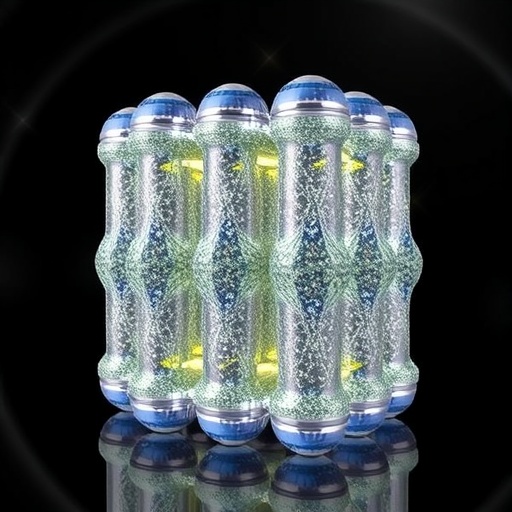In a remarkable development in the realm of energy storage solutions, researchers have unveiled a groundbreaking cathode material intended for aqueous zinc-ion batteries, potentially changing the landscape of energy storage technologies. The study, led by Zhang, Cheng, and Guo, focuses on a uniquely structured multibranched polymer, identified as poly (1,4-benzoquinone-1,2,4,5-tetramethylenediamine), which has the potential to optimize battery performance significantly. These findings not only pave the way for more efficient energy storage methods but also contribute to the sustainability paradigm that many industries are currently striving to achieve.
The catalysts for this research were the growing demand for high-performance batteries and the need for more environmentally friendly alternatives. Traditional lithium-ion batteries, while prevalent, face limitations such as resource scarcity, safety concerns, and environmental impact. This has opened the door for alternative technologies, including zinc-ion batteries, which offer advantages in terms of availability and safety. The innovative polymer developed in this study aims to address these concerns while enhancing the necessary performance metrics of modern batteries.
By developing a multibranched structure, the researchers have provided a solution that allows for better ion transport within the battery, significantly improving charge and discharge rates. The unique molecular architecture of poly (1,4-benzoquinone-1,2,4,5-tetramethylenediamine) facilitates enhanced conductivity and stability in aqueous environments, crucial characteristics for the long-term viability of any energy storage solution. This polymer also integrates seamlessly with carbon nanotubes, resulting in composites that exhibit even further improvements in electrical properties.
The incorporation of carbon nanotubes into the cathode design enhances the overall mechanical strength and electrical conductivity of the composite material, which is essential for high-performance applications. The researchers have found that the synergy between the polymer matrix and carbon nanotube integration establishes a more effective electron transport pathway. This ultimately leads to an increase in the energy density of the resulting zinc-ion battery, marking a significant stride forward in battery technology.
Moreover, the sustainability of each component used in the production of this composite adds another layer of appeal. Zinc is more abundant and less toxic compared to lithium, which makes aqueous zinc-ion batteries a more environmentally friendly alternative without compromising on performance. The multibranched structure and associated composite materials not only showcase a leap in material science but also highlight the importance of considering ecological implications in energy storage solutions.
In a comprehensive series of tests, the new cathode material demonstrated superior cycling stability and retention, key indicators of reliability in energy storage applications. The structured approach taken by the researchers resulted in a minimal decline in capacity over extensive charge-discharge cycles. This performance stability means that consumers may expect longer-lasting applications, something that the current generation of batteries often struggles to boast, making this innovation particularly timely.
Furthermore, the findings contribute significantly to the academic and industrial discourse surrounding energy storage innovation. As battery technologies evolve, the need for rigorous and thorough scientific exploration becomes paramount. Publications like these, showcasing cutting-edge research like that of Zhang et al., can inspire further investigations and innovations in energy materials, beckoning a new era for battery technology [1].
An added advantage of the reported findings is the potential for scalability. The synthesis processes for both the multibranched polymer and its carbon nanotube composites are feasible for larger production levels, which is crucial for commercial viability. The research outcomes not only prioritize effective performance but also consider economic aspects, thereby aligning with market demands for feasible energy solutions.
On a broader scale, the impact of this research could resonate across various sectors, including electric vehicles, renewable energy systems, and portable electronic devices. By enhancing the efficiency and sustainability of energy storage systems, which continue to be a critical focus area worldwide, this innovative approach could very well facilitate the transition to cleaner energy systems, driving both economic growth and sustainable development.
This study also opens up a multitude of avenues for future research. Understanding how variations in polymer structure might influence battery performance can lead to new insights in material sciences. The possibility of tuning the properties of these polymers to optimize performance can further refine the effectiveness of zinc-ion batteries, potentially leading to customized applications tailored to specific energy storage needs.
Additionally, this research encourages further exploration into hybrid systems that could integrate different types of energy storage technologies. Recognizing that no single solution dominates the energy storage landscape is vital. Rather, a combination of technologies—such as lithium-ion, sodium-ion, and zinc-ion batteries—could yield cannabis advancements in energy solutions. This blend could foster resilience and adaptability in the face of varying energy demands.
In conclusion, the introduction of multibranched poly (1,4-benzoquinone-1,2,4,5-tetramethylenediamine) as a cathode material for aqueous zinc-ion batteries marks a significant development in battery technology, aligning performance improvements with environmental sustainability. The collaborative efforts of researchers, highlighted by this study, underscore the critical importance of innovative materials in the pursuit of better energy storage solutions. As society moves towards a more electrified future, breakthroughs such as these will play a pivotal role in shaping the landscape of energy technologies.
With continued research and development, the potential for widespread adoption of zinc-ion batteries, particularly using advanced materials and composites as showcased in this study, may soon become a reality. This paves the way for not just technological improvements but a shift towards sustainable energy practices that benefit both consumers and the planet alike.
Subject of Research: Development of Multibranched Polymer for Zinc-ion Battery Cathodes
Article Title: Multibranched poly (1,4-benzoquinone-1,2,4,5-tetramethylenediamine) and its carbon nanotube composites for aqueous zinc-ion battery cathode.
Article References:
Zhang, J., Cheng, X., Guo, C. et al. Multibranched poly (1,4-benzoquinone-1,2,4,5-tetramethylenediamine) and its carbon nanotube composites for aqueous zinc-ion battery cathode. Ionics (2025). https://doi.org/10.1007/s11581-025-06565-x
Image Credits: AI Generated
DOI: https://doi.org/10.1007/s11581-025-06565-x
Keywords: Zinc-ion Batteries, Multibranched Polymer, Energy Storage, Carbon Nanotubes, Sustainability, Battery Performance, Aqueous Systems.




